Humanoid robots—machines designed to look and act like humans—are no longer confined to science fiction. With advances in artificial intelligence (AI) and robotics, these robots are becoming more integrated into our daily lives, changing the way we interact with technology.
What Are Humanoid Robots?
At their core, humanoid robots are built to resemble human beings. They have a head, torso, arms, and legs, often with the ability to move, speak, and interact with people. Robots like Sophia by Hanson Robotics and Atlas by Boston Dynamics have amazed the world with their human-like features, including the ability to hold conversations, recognize emotions, and perform complex tasks like running or jumping.
Where are they used?
Healthcare: Humanoid robots assist elderly people with daily tasks, offer companionship, and even support medical procedures.
Customer Service: From guiding customers in stores to answering questions at airports, robots are enhancing customer experiences.
Education: In classrooms, robots are helping students learn, especially those with special needs.
Entertainment: Humanoid robots are also showing up in movies, TV shows, and even as performers.
The Future of Humanoid Robots
The potential for humanoid robots is enormous. As AI continues to improve, these robots could handle more complex tasks, make our environments safer, and even offer emotional support. However, there are challenges—like job displacement and ethical concerns—that we’ll need to address as we move forward.
Humanoid robots are no longer a distant dream—they’re here, and they’re shaping the future of technology. The question is: how will we use them? Let us know in the comments!

